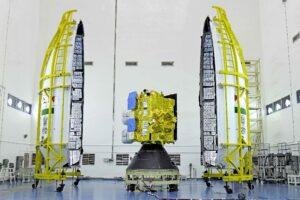
Context
- The Indian National Satellite System, or INSAT for short, is a constellation of multifunctional geostationary satellites launched by ISRO to meet India’s needs in broadcasting, telecommunications, meteorology, and search and rescue.
- INSAT is the Asia Pacific region’s largest domestic communication system.
About INSAT-3DS
- It is intended for improved meteorological observations and surface monitoring for weather forecasting and hazard alerts, both on land and in the ocean.
- Launch Specifics: The Satish Dhawan Space Centre (SDSC) SHAR in Sriharikota, Andhra Pradesh is the launch site for the INSAT-3DS mission.
- Funding: The Ministry of Earth Sciences (MoES) provides all funding.
- Collaboration between the India Meteorological Department (IMD) and ISRO.
- Geosynchronous Launch Vehicle (GSLV-F14) is the launch vehicle. The INSAT-3DS is to be launched into the
- Geosynchronous Transfer Orbit (GTO) by the GSLV.
- Enhancement: The satellite, in conjunction with the currently in operation INSAT-3D and INSAT-3DR satellites, will enhance the Meteorological services.
GSLV-F14 Overview:
- The three-stage, 51.7-meter-long Geosynchronous Satellite Launch Vehicle (GSLV-F14) has a liftoff mass of 420 tonnes.
- Four earth-storable propellant stages (L40) strapons, each holding 40 tons of liquid propellant, plus a solid propellant motor (S139) with 139 tons of propellant make up the first stage (GS1).
- With 40 tons of propellant in it, the second stage (GS2) is likewise an earth-storable propellant stage.
- Liquid oxygen (LOX) and liquid hydrogen (LH2) make up the 15 tons of propellant in the cryogenic third stage (GS3).
- An Ogive payload fairing shields the satellite during the atmospheric regime.
- A wide range of spacecraft, including those intended for communication, navigation, earth resource surveys, and other exclusive missions, can be launched using GSLV-F14.
About Satish Dhawan Space Centre (SDSC):
- Location: Satish Dhawan Space Centre (SDSC) is located in Sriharikota, Andhra Pradesh, India.
- Establishment: Formerly known as Sriharikota Range (SHAR), SDSC was renamed in 2002 in honor of Dr. Satish Dhawan, an eminent Indian space scientist and former chairman of the Indian Space Research Organisation (ISRO).
- Purpose: SDSC is one of the main space launch centers operated by the Indian Space Research Organisation (ISRO). It serves as the primary launch site for India’s satellite launch vehicles.
- Launch Vehicles: SDSC is responsible for the launch of various satellite launch vehicles, including the Polar Satellite Launch Vehicle (PSLV) and the Geosynchronous Satellite Launch Vehicle (GSLV) series.
What is the Aim of the Mission INSAT-3DS?
- Monitoring Earth’s Surface and Oceanic Observations:
- GSLV-F14 is equipped with various spectral channels optimized for meteorological observations.
- These channels enable the satellite to monitor Earth’s surface and oceans with high precision.
- By capturing data across different wavelengths, the satellite can observe phenomena such as cloud cover, sea surface temperatures, vegetation health, and atmospheric composition, aiding in weather forecasting and environmental monitoring efforts.
- Vertical Profile of Meteorological Parameters:
- The satellite is capable of providing vertical profiles of various
- meteorological parameters within the atmosphere.
- This includes data on temperature, humidity, pressure, and other atmospheric conditions at different altitudes.
- These profiles offer valuable insights into atmospheric dynamics, aiding meteorologists in understanding weather patterns and predicting atmospheric phenomena such as cyclones, thunderstorms, and temperature inversions.
- Data Collection and Dissemination:
- GSLV-F14 features Data Collection and Data Dissemination capabilities, particularly from Data Collection Platforms (DCPs).
- These platforms, which can be deployed on land, sea, or air, collect environmental data such as temperature, pressure, and humidity.
- The satellite acts as a relay, collecting data from these platforms and disseminating it to ground stations for further analysis and use in weather forecasting, climate research, and disaster management.
- Satellite-Aided Search and Rescue (SAR) Services:
- GSLV-F14 is equipped to provide Satellite-Aided Search and Rescue services.
- In the event of emergencies such as maritime or aviation incidents, distress signals from emergency beacons can be detected and located by the satellite.
- This information is relayed to search and rescue authorities, facilitating timely and effective response efforts to save lives and ensure the safety of individuals in distress.
People Also Ask
Q1: When is the GSLV-F14/INSAT-3DS mission scheduled for launch?
Ans: The GSLV-F14/INSAT-3DS mission is set for Saturday, February 17, 2024, at 17:30 Hrs. IST.
Q2: What is the purpose of the GSLV-F14/INSAT-3DS mission?
Ans: The mission aims to deploy the INSAT-3DS meteorological satellite into Geosynchronous Transfer Orbit (GTO). INSAT-3DS is designed to enhance meteorological observations, monitor land and ocean surfaces for weather forecasting, and provide disaster warning capabilities. It will augment existing meteorological services alongside INSAT-3D and INSAT-3DR satellites.
Thanks for sharing. I read many of your blog posts, cool, your blog is very good.